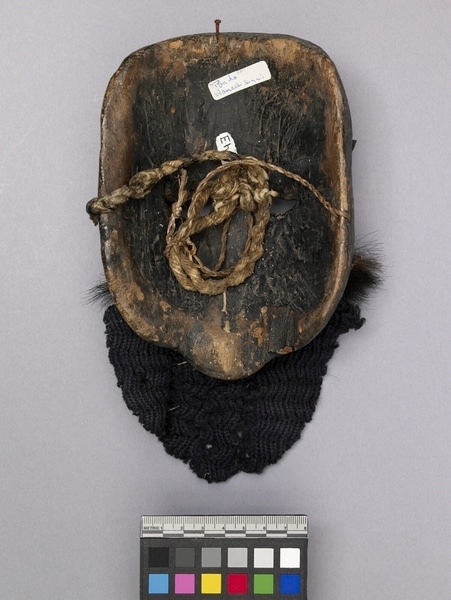Mask Item Number: Eh89 from the MOA: University of British Columbia




Description
Mask depicting a humanoid face (sanni demon mask), pink with black painted hair as well as black on the end of the nose, and at the jaw. Painted black hair and eyebrows. The mask also has slightly protruding eyes with black rims, and a crescent-shaped hole underneath each eye. White plastic teeth and two outwardly curved fangs emerge from under a fur moustache, and the bottom teeth are attached to a plastic bottom lip, which is sewn to a black knit beard. Reverse has a label, which reads, " 'Bada' stomach sanni"; number "650". A strap, composed partly of twined plant fibre and partly cotton string, is attached at the back.
History Of Use
Worn during curing ritual of the Sanni Yakuma ceremony, part of the Tovil series of dramas performed by Sinhalese ritual specialists and dancers. The Sanni Yakuma is intended to combat diseases and afflictions caused by the Sanni group of demons. These consist of 18 or more apparitions of the chief demon, Maha-kola-sanni. The officiating healer honours Buddha, then appeases the demons with offerings, dancing, and chanting. This mask was originally Badi Sanni, who caused stomach problems and was used in Sanni Yakuma ceremonies, but with the addition of the beard and moustache it was adapted into a Kolam character (collector's notes). The Kolam is a rural, satirical folk dance drama.
Cultural Context
exorcism
Item History
- Made in Sri Lanka
- Collected during 1978
- Owned by Jason Schoonover before June 10, 1982
- Received from Jason Schoonover (Seller) and Museum of Anthropology Shop Volunteers (Funding source) on June 10, 1982
What
Who
- Culture
- Sinhalese
- Previous Owner
- Jason Schoonover
- Received from
- Jason Schoonover (Seller) and Museum of Anthropology Shop Volunteers (Funding source)
Where
- Holding Institution
- MOA: University of British Columbia
- Made in
- Sri Lanka
When
- Collection Date
- during 1978
- Ownership Date
- before June 10, 1982
- Acquisition Date
- on June 10, 1982
Other
- Condition
- good
- Current Location
- Case 107
- Accession Number
- 0812/0005